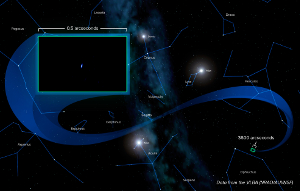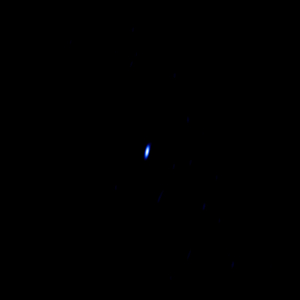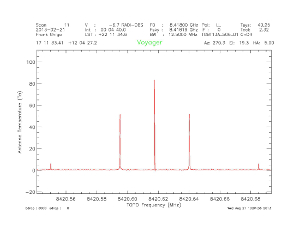September 12, 2013; 2 p.m. EDT
Contact:
Charles Blue, Public Information Officer
Charlottesville, Virginia
(434) 296-0314
cblue@nrao.edu
Voyager 1 Spotted from Earth with NRAO's VLBA and GBT Telescopes
Earlier this year, the National Science Foundation's Very Long Baseline Array telescope turned its gaze to NASA's famed Voyager 1 and captured an image of this iconic spacecraft's faint radio signal. The Green Bank Telescope also detected Voyager's signal, picking it out from the background radio noise in less than one second.

|

|

Full Caption 3 |
Astronomers using the National Science Foundation's (NSF) Very Long Baseline Array (VLBA) and Green Bank Telescope (GBT) spotted the faint radio glow from NASA's famed Voyager 1 spacecraft -- the most distant man-made object.
According to NASA's Jet Propulsion Laboratory (JPL), the VLBA imaged the signal from Voyager 1's main transmitter after the spacecraft had already passed beyond the edge of the heliosphere, the bubble of charged particles from the Sun that surrounds our Solar System.
Using NASA's Deep Space Network, JPL continually tracks Voyager and calculates its position on the sky, which is known as the ephemeris. Since the VLBA has the highest resolution, or ability to see fine detail, of any full-time astronomical instrument, NRAO astronomers believed they could locate Voyager's ephemeris position with unprecedented precision. This is unrelated to Voyager's distance from the Sun or position relative to the heliosphere.
The initial observations, which were made on February 21, placed Voyager very near, but not precisely at its predicted location. The difference was a few tenths of an arcsecond. An arcsecond is the apparent size of a penny as seen from 2.5 miles (4 kilometers) away. The second observations on June 1 produced similar results.
"It is possible that these observations are at the milliarcsecond [one-thousandth of an arcsecond] level, or better," said NRAO scientist Walter Brisken, who led the observations with the VLBA. At 11.5 billion miles -- Voyager's approximate distance at the time of the initial observations -- one milliarcsecond would be roughly 50 miles across.
Voyager's main transmitter shines at a feeble 22 watts, which is comparable to a car-mounted police radio or -- in visible light -- a refrigerator light bulb. Though incredibly weak by the standards of modern wireless communications, Voyager's signal is astoundingly bright when compared to most natural objects studied by radio telescopes.
"The ability to pinpoint the location of Voyager and other spacecraft is critical as we explore the inner Solar System and beyond," said Brisken. "The NRAO's VLBA has the capability to do this vital task with unprecedented precision."
Voyager 1, which was launched in 1977, is now headed away from the Sun at a speed of about 38,000 miles per hour.
In a remarkably sensitive complementary observation, the NRAO's Green Bank Telescope (GBT), which is the world's largest fully steerable radio telescope, easily detected Voyager's signal, picking it out from the background radio noise in less than one second.
"Voyager is the first man-made object to penetrate the interstellar medium, and we really want to be able to receive the data from this new frontier," said NRAO scientist Toney Minter, who oversaw the Green Bank observations. "This information will provide many clues about how the interstellar medium behaves and how the Sun interacts with it."
"NRAO's instruments have the capability to provide the most accurate position information of distant spacecraft like Voyager," said NRAO Director Tony Beasley. "The remarkable sensitivity of GBT and VLBA's sharp vision are essential for discovery but also have unique capabilities that have enabled us to make this contact with one of humanity's most ambitious missions of exploration."
The VLBA is a system of radio antennas located across the United States from Hawaii to St. Croix. The antennas work together as a single telescope nearly 5,000 miles across, giving the VLBA its ability to see fine details. Only seven of the VLBA's full complement of 10 antennas were used to make these observations.
The 100-meter GBT is located in the National Radio Quiet Zone and the West Virginia Radio Astronomy Zone, which protect the incredibly sensitive telescope from unwanted radio interference. The GBT observations were made by NRAO scientists Toney Minter and Frank Ghigo, and Green Bank Director Karen O'Neil.
###
These observations are not related to any publication or scientific presentation.
Click here for HD version of this animation
Animation Caption 4: This animation produced by NRAO using NASA's digital model illustrates Voyager as it journeys out of our Solar System toward interstellar space.
Credit: Brian Kent, NRAO/AUI/NSF; Brian Kumanchik & Christian Lopez, NASA.
